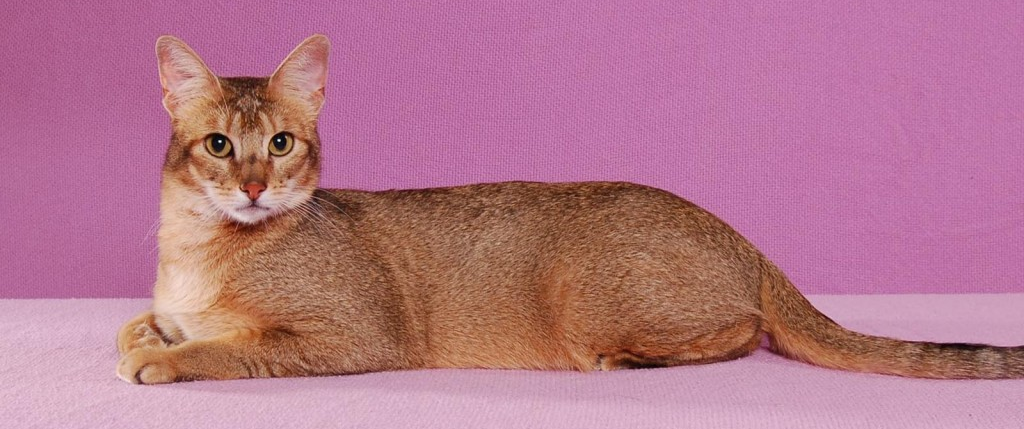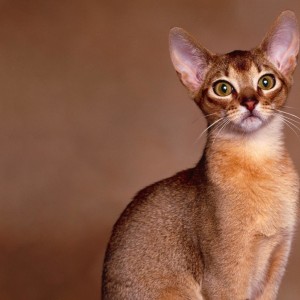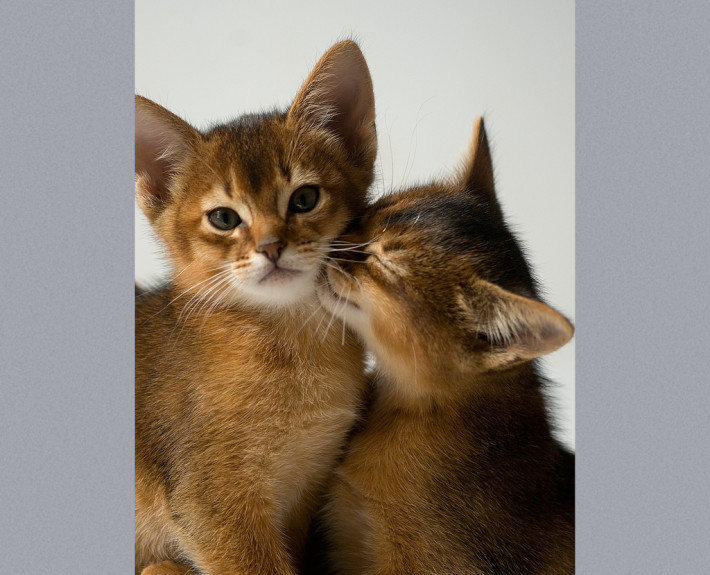Abyssinian

Meoww!!
The Abyssinian personality is friendly, outgoing, interactive, and inquisitive, sometimes dangerously so. They are fearless and can get themselves in trouble if not properly supervised.
In 5 Words
- Active
- Playful
- Inquisitive
- Friendly
- Outgoing
Snapshot
Size: 60cm (2ft)
Weight: 9 – 16 lbs
Origin: Egypt
Life Span: 9-15 Years
Colour: Fawn, Red, Blue, Grey
Litter Size: Average of 6

Characteristics
Learn About the Abyssinian
The name ‘Abyssinian’ tells of Abyssinia origin, now named Ethiopia; however most of the stories about the origins of Abyssinians point back to Egypt. Ethiopia was formerly known as Abyssinia but it was not that factor that led to their name. But because the first “Abyssinians” exhibited in shows were said to be imported from that country. Research about their origin has been made and it was suggested that these cats may have been bought from wild animal traders by colonists living near the coast of the Indian Ocean. The Abyssinian has been developed in Great Britain.
Genetic research show that the closest place the Abyssinians could have originated would be from parts of Southeast Asia and the coast of the Indian Ocean. The Leiden Zoological Museum in Holland has the earliest identifiable Abyssinian taxidermy. When this cay was bought around 1834 to 1836, the museum founder labeled it as “Patrie, domestica India”. Although Aby was developed in England, it found its way there by merchants and colonists stopping in Calcutta, the primary port of the Indian Ocean.
This breed attracted many speculations with its origin and one of which is being a descendant of an Egyptian female kitten named Zula. She was brought to England in 1868 when a British soldier took her from a port in Alexandria. However, this remains to be a theory because no solid link can be found between Zula and the first cat recognized as Abyssinian in the year 1882.
Several sources tell of the usual story of the Abyssinian breed coming from Ancient Egypt and is said to be around for a few thousand years. The images of cats painted by Ancient Egyptians closely resemble this particular breed. They have characteristics of having almond shaped eyes, large ears, beautiful arched neck, and a muscular body yet stays elegant. There are also stories that there are wild “Abyssinians” that reside in North Africa nowadays.
The Abyssinian cat is a breed which is playful, very active, and inquisitive as well. It has a unique coat pattern similar to how wild cats’ furs are ticked. They are a slender and short-haired breed. They have large pointed, alert ears. They have moderately wedge-shaped broad heads. Their eyes can be of color green, hazel, copper or gold. They have a long tail which is broad at the base and narrowing to the end. An m-shaped marking is noticeable in most Abyssinian cats. These medium sized cats can be colored ruddy, cream, read, lilac, sorrel, fawn, blue or chocolate. Their strong, lithe bodies are supported by their long legs.
They are often called the ruddy ticked cat due to its color and fur. “Ruddy” is called “Usual” in the United Kingdom. They have black ticked warm reddish-brown coats. The back of their hind legs and feet are black. There have been many coat colors over the years but the markings on it are always the same.
Their personalities can be similar with most toddlers: inquisitive, friendly, interactive and outgoing. They are fearless, which means they could get easily in trouble if you don’t have your eyes on them. Upon waking up, they are able to establish a “to-do” list and don’t rest until they are able to accomplish every item on the list. This breed can also be very stubborn and tricky to distract when they’re thinking about something.
Abyssinians are not your usual cats. They would not sleep all day like most cats or likes cuddling all the time. You couldn’t just leave it lying all day since they need to channel their energy somewhere, particularly during play with their owner. They are high-spirited, curious, intelligent, extremely active and courageous. They are known for being curious and taking risks exploring surroundings including heights. They may be adventurous but they are intelligent enough not to take unnecessary risks. They are formidable hunters as they are physically capable and cunning. They can be very successful show cats, making them famous among owners and breeders. Despite their playful nature, their voices tend to be quiet and engaging.
If you restrain them, they can be troublesome. They like entertaining themselves but they like it more when they are able to incorporate themselves in every aspect of your life. Some of them can be taught how to fetch. They can get depressed if their hunger for love and interaction is not met. They can get along well with other cats. They are particularly drawn in at dinnertime. You can notice how they tend to grab your attention during meal time, especially at dinner!
The Abyssinian cat is a vigorous, healthy breed; and is fairly easy to groom. However, some pure breed lines may have inherited health problems that could include:
- Gingivitis (gum disease)
- Renal amyloidosis (which is a deposit of fibrils in the kidneys)
- Pyruvate kinase (which results in anemia)
- Lysosomal accumulation neuropathy (neurological disease)
- Patellar luxation (a condition where the knee caps slip)
- Hypothyroidism, (under secretion of the thyroid hormone)
- Retinal atrophy (which causes impaired vision)
It is always advisable to invest in health cat insurance for your pet and always purchase your Abyssinian cat or kitten from a trustworthy cat breeder.
Abyssinians require low maintenance, but it is a good thing to brush their coats every week or so. You can use a comb or brush to help maintain its healthy coat. You can also consider using a silk scarf or chamois leather coat to give their ticked coat a gorgeous shine.
When an Abyssinian kitten is less than a year old, it needs to eat three times a day. When it becomes a year old, it can be fed only twice per day but in larger portions. They are sensitive with their food and they make sure they let you know if the food you serve them is not to their liking. If your Abyssinian cat has not touched its food after ten minutes from being served, you might have to discover a new cat food formula that it will like. They also need enough water given their very active nature.
Abyssinian cats will do great with a diet consisting of red meat including lamb hearts and kidneys, gravy beef, and chuck steak. If you intend to feed your Aby cat with raw meat, make sure that the meat is chopped into bite-size pieces. If you want to go with white meat instead, choose rabbit or chicken meat. Be careful of feeding your cat any dairy product because despite their love for cheese, they may not be able to digest these.
Like most cats, Abyssinians love to drink milk. However, it can pose a danger to their gastrointestinal system. They are lactose intolerant since birth and may experience diarrhea should they consume milk products. Then again, there are some milk products that can be consumed by cats and they can usually be seen in pet stores.






